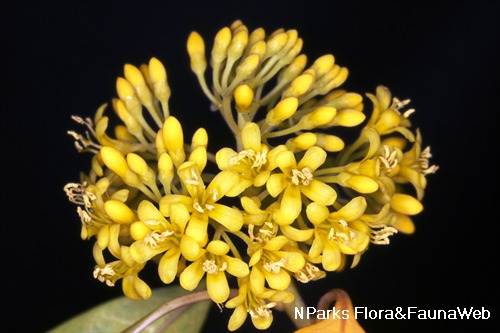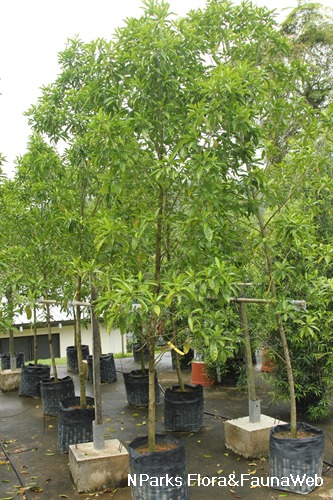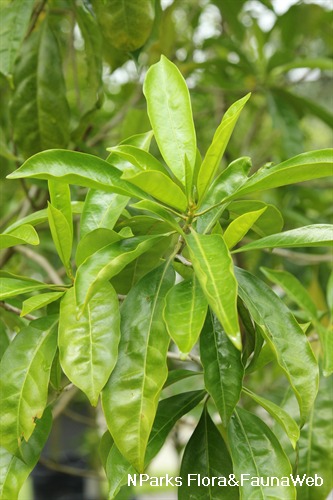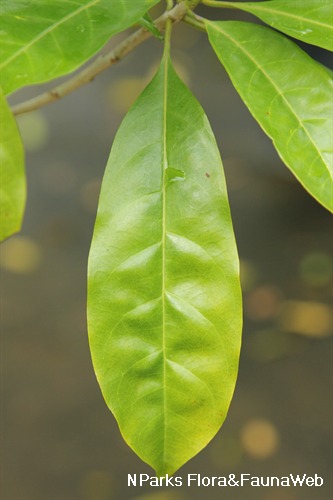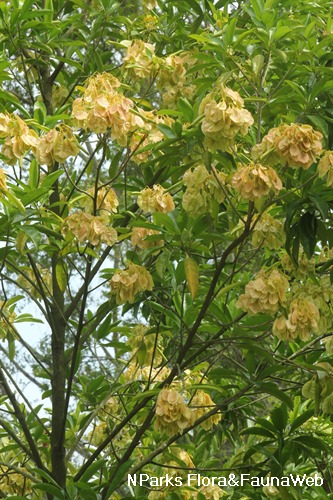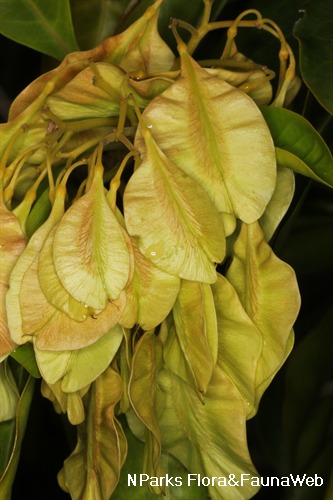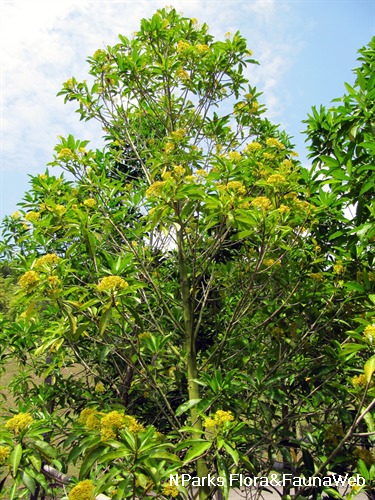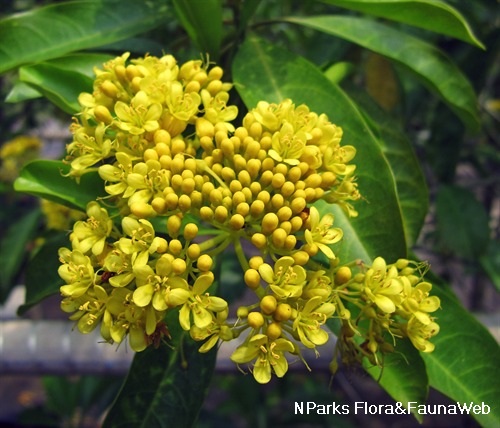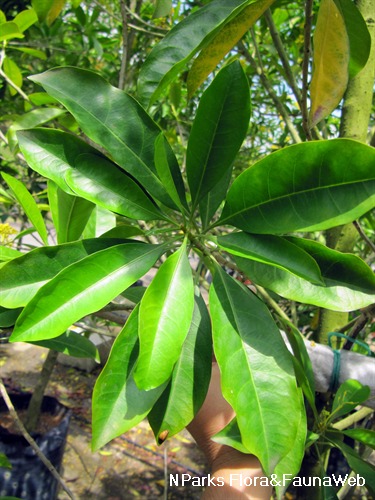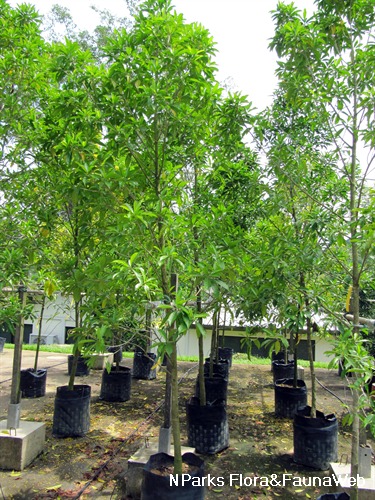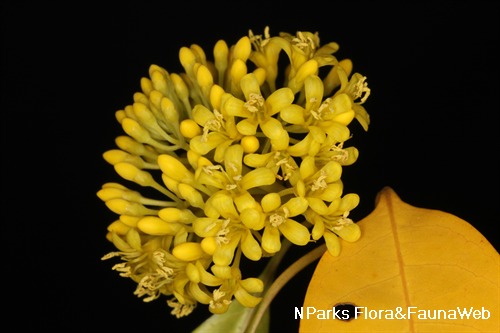
Back
Pteleocarpa lamponga (Miq.) Bakh. ex Heyne
| Family Name: | Gelsemiaceae |
| Common Name: | Tembusu Tikus |
Name
Classifications and Characteristics
| Plant Division | Angiosperms (Flowering Seed Plants) (Dicotyledon) |
|---|---|
| Plant Growth Form | Tree (Big (>30m)) |
| Lifespan (in Singapore) | Perennial |
| Plant Shape | Irregular |
| Maximum Height | 37 m |
Biogeography
| Native Distribution | Southern Thailand, Peninsular Malaysia, Singapore, Sumatra, Borneo |
|---|---|
| Native Habitat | Terrestrial (Primary Rainforest) |
| Preferred Climate Zone | Tropical, Sub-Tropical / Monsoonal |
| Local Conservation Status | Native to Singapore (Presumed Nationally Extinct (NEx)) |
Description and Ethnobotany
| Growth Form | It is a tree up to 37 m tall, with a bushy crown. |
|---|---|
| Crown | Irregular and bushy. |
| Foliage | Its alternate, stalked leaves have membranous to thinly leathery leaf blades that are variable in shape, withering yellow, and 2.5–14 by 1–6 cm. The base of the leaf blade gradually tapers into the leaf stalk. |
| Flowers | Numerous flowers with usually bright yellow (rarely, red) petals are found in clusters on the many-branched shoots at the ends of leafy twigs. |
| Fruit | Its one-seeded fruits are winged, flat, and pink to light red when ripe. The wings are broadly oval to circular, and up to 5.5 by 5 cm, with distinctly notched to deeply bifid (split into two) tips. |
| Habitat | It grows in primary lowland and hill forests up to 600 m altitude. |
| Associated Fauna | Its flowers are insect-pollinated. |
| Cultivation | It can be propagated by seed. |
| Etymology | Greek Ptelea, a tree from the Rutaceae (citrus family); Greek karpos, fruit, referring to the fruits resembling that of Ptelea species; Latin lamponga, of Lampong, Sumatra, referring to one locality in the natural distribution of this species |
| Ethnobotanical Uses | Edible Plant Parts : Edible Seeds Food (Herb or Spice): The ripe seeds are used as flavouring. Timber & Products: The rather durable timber is used in making roof supports. |
Landscaping Features
| Landscaping | It is suitable for parks, streetscape planting and gardens for its attractive bright yellow bunches of flowers, pink fruits and bushy crown. |
|---|---|
| Desirable Plant Features | Ornamental Flowers, Ornamental Fruits, Ornamental Form |
| Landscape Uses | General, Suitable for Roadsides, Parks & Gardens, Small Gardens |
| Thematic Landscaping | Golden Garden, Naturalistic Garden |
Fauna, Pollination and Dispersal
| Pollination Method(s) | Biotic (Fauna) |
|---|---|
| Seed or Spore Dispersal | Abiotic |
Plant Care and Propagation
| Light Preference | Full Sun, Semi-Shade |
|---|---|
| Water Preference | Moderate Water |
| Plant Growth Rate | Moderate |
| Rootzone Tolerance | Moist Soils, Well-Drained Soils, Fertile Loamy Soils |
| Maintenance Requirements | Moderate |
| Propagation Method | Seed |
Foliar
| Foliage Retention | Evergreen |
|---|---|
| Mature Foliage Colour(s) | Green |
| Mature Foliage Texture(s) | Leathery, Thin |
| Foliar Type | Simple / Unifoliate |
| Foliar Arrangement Along Stem | Alternate |
| Foliar Attachment to Stem | Petiolate |
| Foliar Shape(s) | Non-Palm Foliage (Obovate, Elliptical) |
| Foliar Venation | Pinnate / Net |
| Foliar Margin | Entire |
| Foliar Apex - Tip | Acute |
| Foliar Base | Acute |
Floral (Angiosperm)
| Flower & Plant Sexuality | Bisexual Flowers |
| Flower Colour(s) | Yellow / Golden |
|---|---|
| Flower Grouping | Cluster / Inflorescence |
| Flower Location | Terminal |
| Individual Flower Shape | Funnelform / Funnel-shaped |
| Inflorescence Type | Compound Corymb |
Fruit, Seed and Spore
| Mature Fruit Colour(s) | Pink |
|---|---|
| Mature Fruit Texture(s) | Papery |
| Fruit Classification | Simple Fruit |
| Fruit Type |
References
| References | Struwe, L., Soza, V.L., Sugumaran, M., & Olmstead, R.G.. 2014. Gelsemiaceae (Gentianales) expanded to include the enigmatic Asian genus Pteleocarpa. Botanical Journal of the Linnean Society. 175. 482 – 496 |
|---|
Image Repository
Others
| Master ID | 29062 |
|---|---|
| Species ID | 3381 |
| Flora Disclaimer | The information in this website has been compiled from reliable sources, such as reference works on medicinal plants. It is not a substitute for medical advice or treatment and NParks does not purport to provide any medical advice. Readers should always consult his/her physician before using or consuming a plant for medicinal purposes. |

